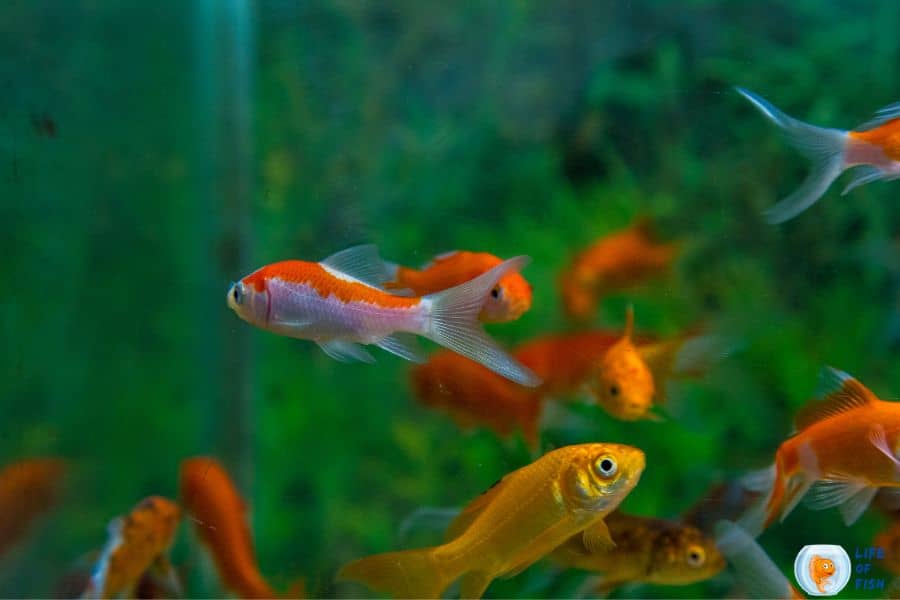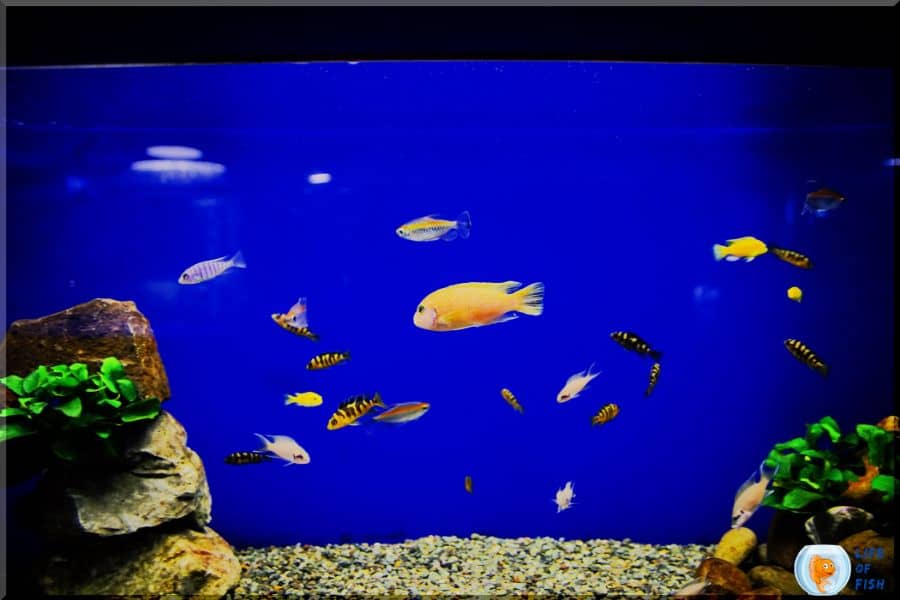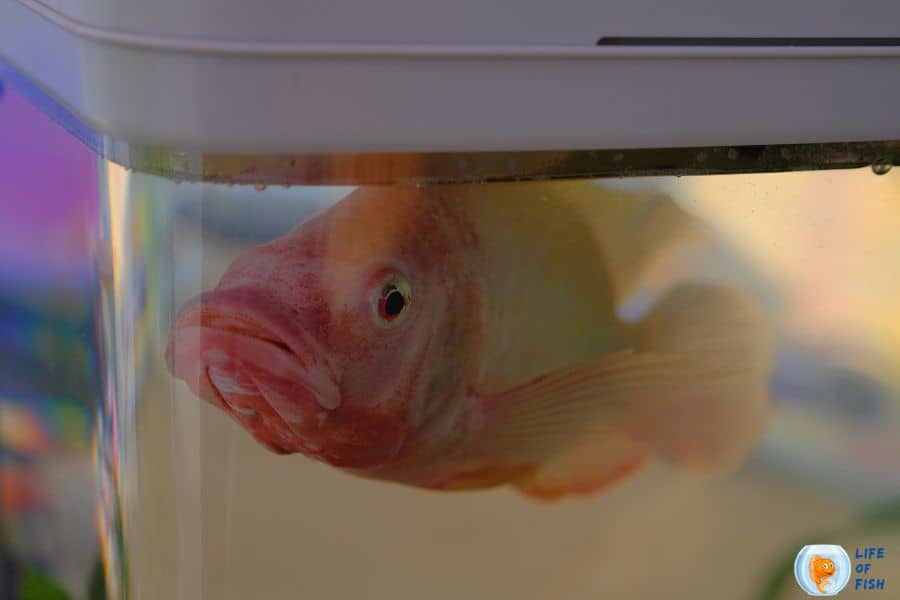A Hospital tank, commonly known as a quarantine tank, is an additional tank set up to house new fish or sick fishes separately from the main tank. This is done to prevent the disease outbreak and ensure the new fishes are not sick. But do you know How Long To Keep Fish In A Hospital Tank?

There are two types of hospital tanks: short-term and long-term. Short-term hospital tanks are used for newly purchased fish that are not yet acclimated to the main tank, while long-term hospital tanks are used for sick fish.
However, there is a recommended time frame for keeping your fish in a hospital tank irrespective of their condition. Let’s talk about this topic in this article.
The uses of the hospital tank
Jump To
- 1 The uses of the hospital tank
- 2 How long to keep fish in a hospital tank
- 3 Does a hospital tank need to be cycled?
- 4 Ways to instantly cycle hospital tank
- 5 Emergency hospital tank setup
- 6 How to set up the hospital tank
- 7 What size hospital tank do I need?
- 8 Should a hospital tank have gravel?
- 9 Does the hospital tank need a filter?
- 10 How do I transfer my fish from a quarantine tank?
- 11 Related questions
- 12 Conclusion
As mentioned, hospital tanks are used for two purposes: to acclimate new fishes and house sick fishes.
When you bring new fish home, it is best to put them in a quarantine hospital tank for a week or two before adding them to the main tank. This is because new fishes are usually stressed from the trip and need time to adjust to their new environment. In addition, putting them in a hospital tank will allow you to observe them for any sign of disease.
If you have sick fish in your main tank, it is best to remove them and put them in a hospital tank. This is to prevent fish diseases outbreak and ensure that the sick fishes are not getting stressed by the other fishes.
How long to keep fish in a hospital tank
The recommended time frame to quarantine fish in a hospital tank is two weeks. This will allow them to adjust to their new environment and make sure that they are not sick.
For sick fishes, the recommended time frame to keep them in a hospital tank is until they have recovered. This can be anywhere from a few days to a few weeks, depending on the severity of the sickness.
As a rule of thumb, experts recommend keeping any healthy fish, sick fish, invertebrates, plants, and decorations in a hospital tank for about 2 to 4 weeks before adding them to your display tank.
This will help ensure that your main tank stays healthy and disease-free.

Does a hospital tank need to be cycled?
Generally, a hospital tank does not need to be cycled as you will only use it for a short period. If you can cycle a hospital tank, it will be better. But the medications used to treat your fish can kill beneficial bacteria.
Further, you will also have to do partial water changes in your hospital tank regularly to remove toxins that can harm your fish. So, it will be no use to cycle a hospital tank.
However, cycling your hospital tank is preferred if you plan to keep new fish with no visible infections. Fortunately, there are a few ways to cycle your hospital tank instantly.
Ways to instantly cycle hospital tank
Cycling is the process of establishing a colony of beneficial bacteria in your tank that will help break down ammonia and nitrites. Ammonia and nitrites are toxic to your fish and can kill them if the levels get too high.
The beneficial bacteria you need to establish in your tank will come from the fish themselves, the filter, or any other equipment in your main tank. However, the beneficial bacteria can take a few weeks to establish themselves in your tank. So, if you don’t want to wait for the beneficial bacteria to establish themselves, you can use a few methods to cycle your hospital tank instantly.
Buy beneficial bacteria
One way to instantly cycle your hospital tank is using a product containing live bacteria. These products are available in pet stores and online. They will help to establish a colony of beneficial bacteria in your tank that will break down ammonia and nitrites.
Use a filter from an already established tank.
Another way to instantly cycle your hospital tank is to use a filter from an already established tank. The beneficial bacteria that you need to establish in your tank will come from the filter.
However, you need to remove the filter from an already established tank and put it in your hospital tank. Ensure the filter is properly cleaned before putting it in your hospital tank.
You can also use a powerhead or an airstone to help circulate the water in your hospital tank.
Use filter media from an already established tank.
Another way to instantly cycle your hospital tank is to use filter media from an already established tank. The beneficial bacteria that you need to establish in your tank will come from the filter media.
You will need to remove the filter media from an already established tank and put it in your hospital tank. Ensure the filter media is properly cleaned before putting it in your hospital tank.
Use gravel from an already established tank.
Another way to instantly cycle your hospital tank is to use gravel from an already established tank. The beneficial bacteria that you need to establish in your tank will come from the gravel.
You will need to remove some of the gravel from an already established tank and put it in your hospital tank. Ensure the gravel is properly cleaned before putting it in your hospital tank.
Note: Removing filter, filter media, or gravel from an already established tank doesn’t harm the main tank as the beneficial bacteria are present in every nook and cranny of the tank. So, do not be afraid to use these methods to cycle your hospital tank instantly.

Emergency hospital tank setup
Setting up an emergency hospital tank is easier than you think. All you need is a tank, an air pump, an air stone, and a few other things.
Here is a list of what you will need to set up an emergency hospital tank:
A tank: You can use any type of tank for your hospital tank. A small aquarium or a plastic storage container will work just fine.
An air pump: An air pump is used to circulate the water in your tank. It is also used to oxygenate the water.
An air stone: An air stone is used to diffuse the air bubbles from the air pump.
Water: You will need clean, treated water for your hospital tank.
A heater: A heater is used to maintain a stable water temperature in your tank.
A thermometer: A thermometer monitors the water temperature in your tank.
Gravel: Gravel is used to creating a substrate for your hospital tank. It also helps to keep the water clean. However, it is not required.
A filter: A filter removes debris and waste from the water. It also helps to keep the water clean.
Live plants: Live plants are not required, but they are beneficial. They help improve the water quality and provide oxygen for your fish.
How to set up the hospital tank
Arrange the tank
First, you will need to arrange the tank. Place the tank in a location that is out of the way. You should also ensure that the tank is not in direct sunlight.
Fill the tank with water.
Next, you will need to fill the tank with water. If you are using tap water, you must treat it with a water conditioner.
Install the air stone, filter, and other equipment
Next, you will need to install the air stone, filter, and other equipment. Once everything is installed, you must turn on the air pump and the filter.
Using a heater, you will need to set it to the appropriate temperature.
Let the tank cycle
Once the tank is set up, you will need to cycle it. You can instantly cycle the tank using an established tank’s filter media, gravel, or live plants.
If you are not using any of those methods, you will need to wait for the tank to cycle naturally. This process can take up to 8 weeks.
Note: For sick fish, cycling is not necessary.
Add your fish
Once the tank is cycled, you will need to add your fish. You will need to acclimate them to the new tank before adding them.
To do this, you will need to add water from the hospital tank to their container slowly. You will need to do this over the course of an hour.
After the fish have been acclimated, you will need to add them to the hospital tank.
What size hospital tank do I need?
Different fish require different-sized hospital tanks. Smaller fish can be kept in a 2.5-gallon tank, while larger fish need a minimum of 10 gallons.
When setting up your hospital tank, you must ensure that it is big enough for your fish species.
Should a hospital tank have gravel?
No. Adding gravel to a hospital tank is unnecessary and can harm your fish.
Gravel can harbor bacteria and parasites that can infect your fish. If you do use gravel, you will need to clean it often.
Does the hospital tank need a filter?
Yes. A filter is necessary for a hospital tank. It helps to remove debris and waste from the water. It also helps to keep the water clean.
How do I transfer my fish from a quarantine tank?
Once your fish has completed treatment and verified that they are healthy, you will need to acclimate them to their new environment.
To do this, you will need to slowly add water from the hospital tank to their new tank. You will need to do this over the course of an hour.
After the fish have been acclimated, you can add them to their new tank.

Related questions
Do I have to quarantine my first fish?
No. You do not have to quarantine your first fish. However, it is recommended.
How many fish can you put in a quarantine tank?
The amount of fish you can put in a quarantine tank depends on the tank size. A general rule of thumb is 1 inch of fish per gallon.
Can I quarantine two fish together?
You can put two fish in a quarantine tank if they are the same species and are compatible. You will need to ensure that the tank is large enough for both fish.
Conclusion
A hospital tank is a necessity for any fish keeper. It is a safe place to house sick or injured fish. It is also where you can keep new fish until you are sure they are not sick.
How Long To Keep Fish In A Hospital Tank differs depending on fish size and the severity of their illness. You will most likely need to keep sick fish in a hospital tank for 2-4 weeks.
You should keep them in a hospital tank for at least two weeks if they are healthy, new fish. This will give you time to observe them and ensure they are healthy.
Read Next : Can Fish Recover From Shock? (The Shocking Truth)
